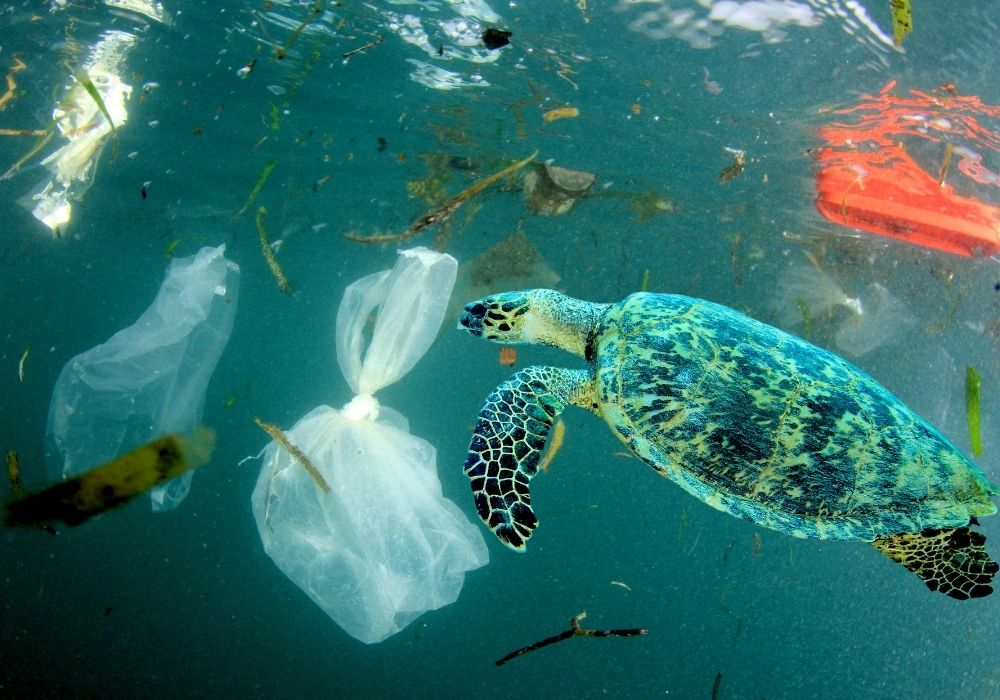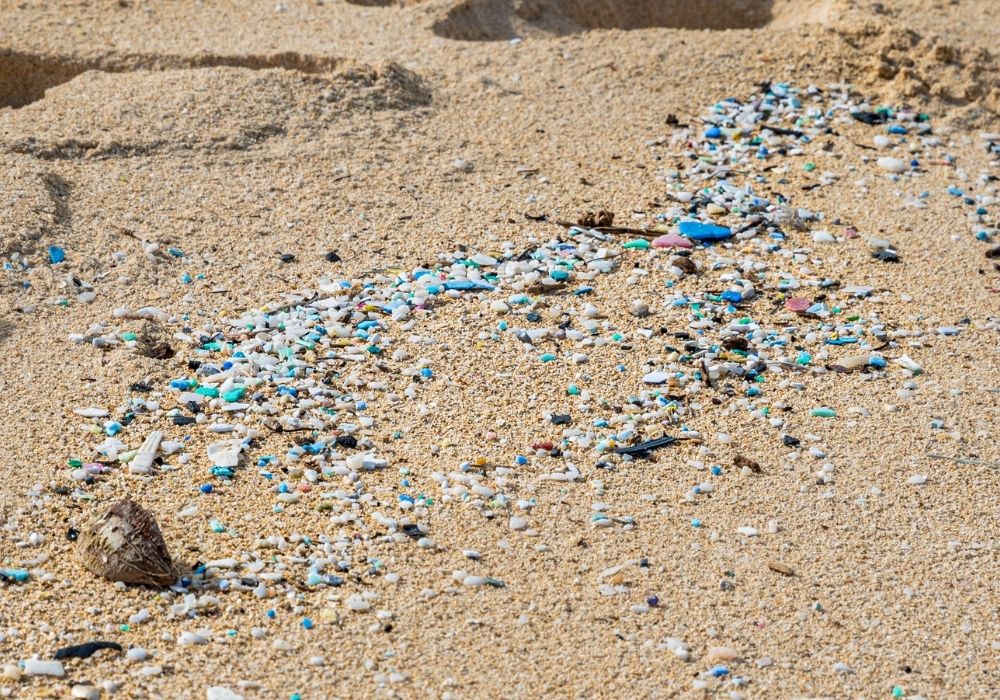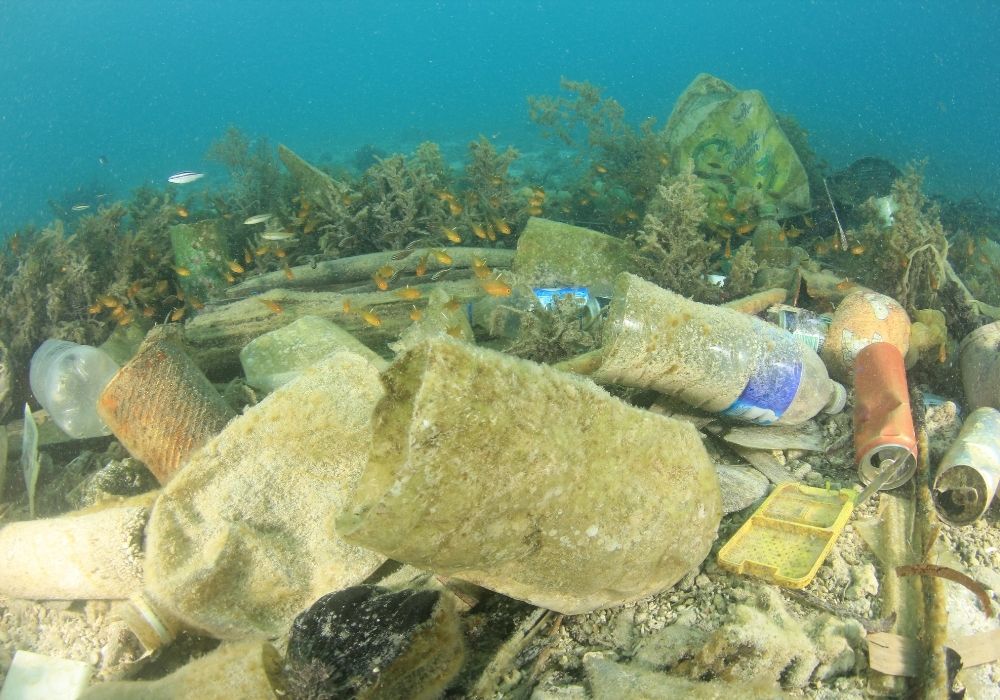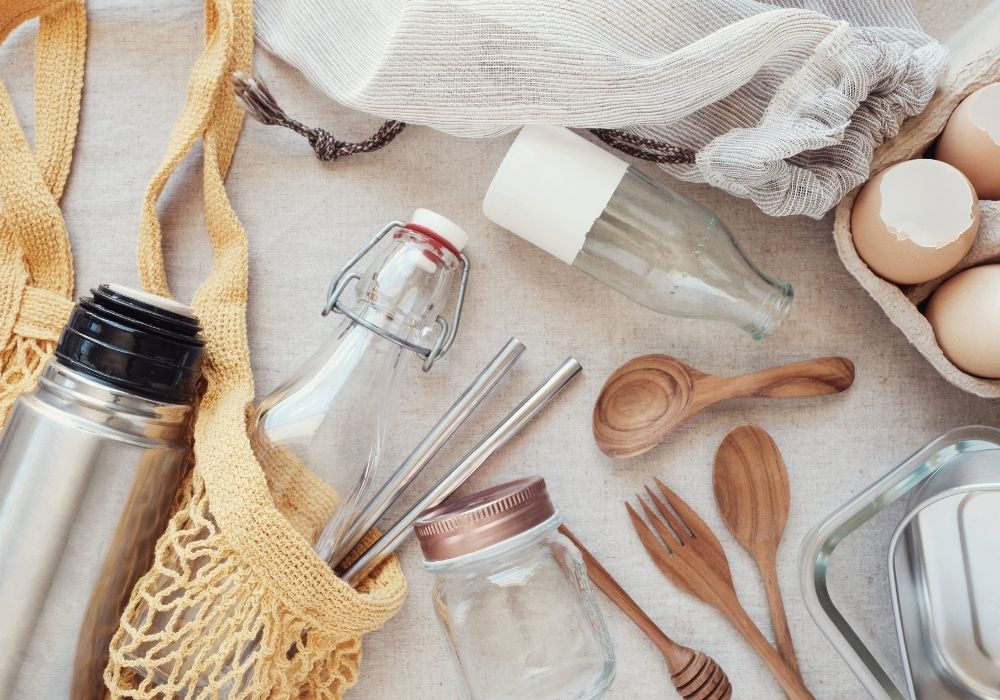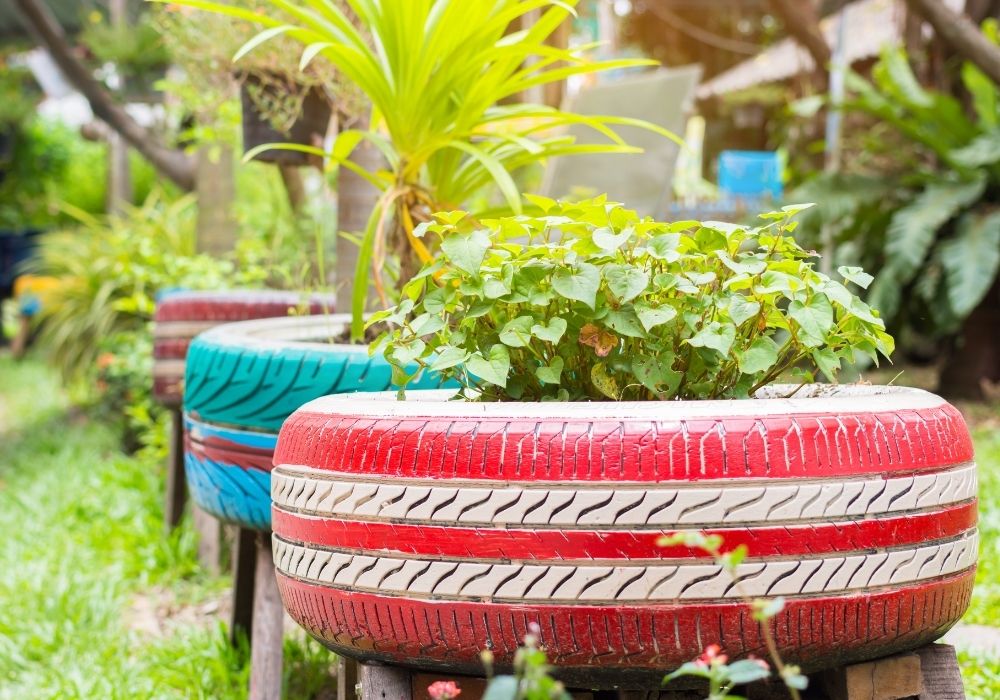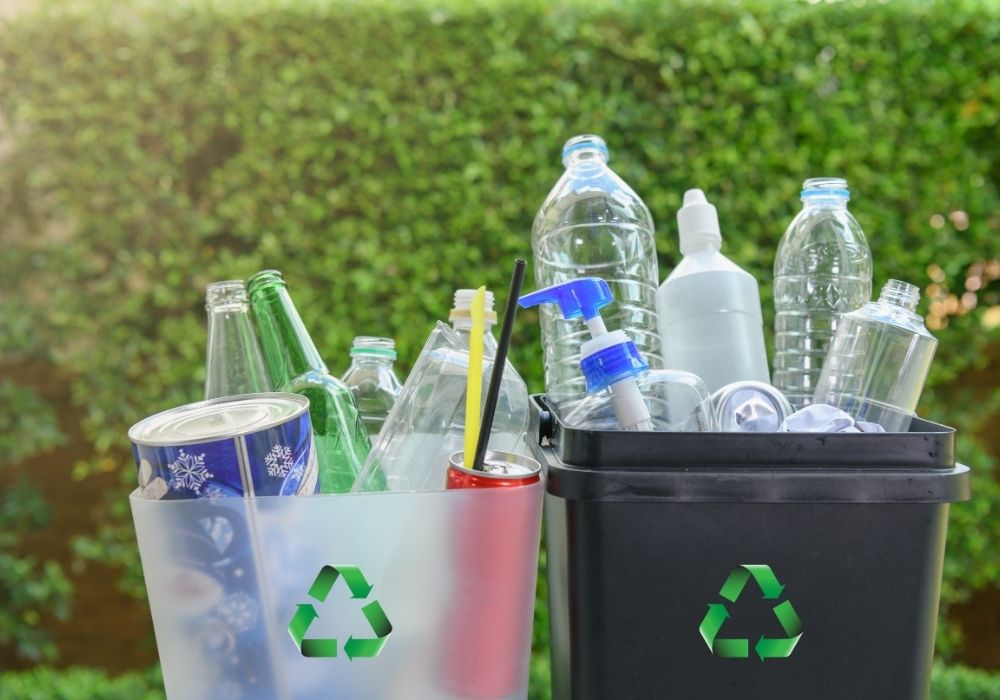“Water and air, the two essential fluids on which all life depends, have become global garbage cans”
Jacques Cousteau
Earth, we have a problem. A big problem. It’s the vast amount of plastic pollution in the planet’s oceans.
Plastic is absolutely everywhere.
Look around you and you’ll notice how it is present in every part of life. Plastic is easy to produce, it is extremely cheap, and it’s versatile. Not only that, it doesn’t corrode, it’s light, and we can use it to do an amazing number of things.
However, we are addicted to it, and our misuse of plastic is out of control. This substance is poisoning our oceans and causing damage all over the planet. Something needs to be done before it’s too late.
This is a comprehensive guide to plastic in the ocean and what you can do to help.
Some facts about ocean plastic pollution
- Every year, we produce over 300 million tons of plastic. It sounds unbelievable, but this enormous figure is actually set to double in the next fourteen years.
- Plastic can be found on every single beach in the entire world. For every mile of beach in the UK, there are 150 plastic bottles littering the shores.
- Plastic has even been found deep within the ice in the arctic.
- There are five enormous swirling garbage patches in the ocean, called Gyres, two of which converge in the Pacific, a large proportion of which are made up of plastic.
- 33% of all plastic produced is used once, and almost half of the plastic produced becomes rubbish within a year.
The problem with plastics in our oceans
Although plastic is not the only contaminant to enter the oceans, the big issue that makes plastic so horribly problematic is that it does not biodegrade. That means it never goes away. It just gets smaller and smaller and smaller.
Scarily, the rubbish you see floating on the surface is only about 1% of the plastic in our oceans. The rest gets caught in the sediment at the bottom of the ocean, or becomes part of swirling clouds of plastic (gyres) that cause devastation all over the world.
Plastic that enters the ocean keeps breaking down due to UV rays from the sun, ocean and river currents, wind, salt, and so on. They get increasingly tinier and become what are referred to as microplastics. These are pieces of plastic the size of confetti and even smaller.
In fact, some pieces of plastic are so small that they can’t be seen with the naked eye. These are known as nanoplastics.
Because of their tiny size, microplastics and nanoplastics get into the ecosystem. And this plastic entering the marine environment causes a great amount of harm. Partly because of the toxic chemicals that plastic is made of, and partly due to animals mistaking this plastic for something they can eat.
What do microplastics and nanoplastics do in the ocean?
Animals are the biggest victim of plastic pollution. Plastic harms them in several ways – they ingest the plastic swirling around the oceans, and they also get entangled in plastic and die. Each year, one million birds and 100,000 marine animals die as a result of plastic pollution.
In fact, scientists have found that ALL baby sea turtles investigated in recent years have plastic inside their bodies. This is because the turtles mistake this plastic for food and eat it, leading them to starve to death.
It’s not only turtles.
Lots of other creatures eat plastic, also mistaking it for food. They starve because their stomachs are filled with plastic. Eating plastic stops them from swimming properly and causes all sorts of injuries and infections.
Microplastics are also harmful to humans because they get into the food we eat – this may partly be due to us consuming seafood which contains microplastics.
Because this pollution due to microplastics is a relatively new phenomenon, it’s not that easy to say how consuming microplastics affects humans with great certainty. Not enough time has passed for conclusive research to be done into the exact ways that humans are harmed by plastic. We are living in one giant plastic experiment, and the results don’t look too promising.
It’s not just the microplastics that is the issue. The toxic substances that plastic releases, such as Bisphenol A and polystyrene-based oligomers, are particularly harmful when they get broken down. Because they do not occur naturally, they damage the growth and development of marine life. They dissolve into the water and harm animals and humans.
Styrofoam breaks down rapidly in the sea, releasing chemicals that are known to cause brain cancer. These chemicals may get into our water system and cause health problems.
We may not know exactly what happens when we consume plastic, either through water or the food we eat. What we do know is that the chemicals in plastic, which we are ingesting, contain chemicals that are very damaging to human health. These chemicals can cause reproductive problems, obesity, developmental issues and problems with organs in the body.
Other problems with plastic in the ocean
Invasive marine species (such as bacteria or crustaceans) can also spread more easily as a result of floating plastic. A large number of marine species have been found to survive for six years floating on pieces of plastic, meaning that they can travel across the world using plastic as a form of transport and reproduce on a much larger scale. These invasive species cause a great deal of damage to the ecosystems that they invade, for example, by carrying novel parasites with them.
Another major issue is that developing countries do not have the infrastructure to deal with plastic pollution. 70% of all of the plastic waste in the ocean comes from developing countries. As well as the issues with plastic getting into the ocean, many countries in Africa and Asia deal with plastic by burning it, which leads to the production of black carbon, another cause of global warming and poor human health.
How long does it take for plastic to decompose in the ocean?
Plastics can take anything from 20 to 1000 years to ‘break down’, but they never fully decompose.
There is no bacteria or enzyme on Earth that can cause all of the chemicals in plastic to biodegrade. With sunlight and currents, pieces of plastic just continue to break down into smaller bits – the microplastics we talked about above – and release harmful chemicals.
All plastic that has ever been made still exists and will exist forever. It cannot go back to its former state and exists as microplastics and chemical by-products such as the Bisphenol A we mentioned earlier. And because so much of the existing plastic is so small, we can’t extract it easily from the oceans.
How much plastic is in the ocean?
Although it’s not known exactly how much plastic there is in the ocean, scientists estimate that an average of 8 million pieces of plastic enter the ocean each day, and that there is a total of 269,000 tons of microplastics and nanoplastics in the ocean now, the equivalent of 38,000 African elephants.
It’s hard to determine how much plastic is in the ocean because it comes from so many places. Most of it is so small that it’s difficult to tell what it was originally and where it has come from.
Plastic is extremely difficult to measure because it’s difficult to tell where it is . It is also hard to measure because it usually involves catching plastic with fine-mesh nets and counting it by hand.
The Center for Biological Diversity reports that by 2050, plastic will outweigh all of the fish in the sea. They also state that there is not a square mile of the surface of the ocean that is free of plastic.
You may have seen beaches covered in plastic before. Some shorelines are worse than others. The North Pacific and Indian Oceans have the largest proportion of plastic in them, accounting for 56% of all plastic pollution.
Take note that what you see on the surface is only a tiny part of the plastic that is actually in the sea. The plastic which stays on the surface tends to be lighter types of plastic, with the majority of plastic being heavier and sinking further down. It looks bad, but the problem is even worse than it looks.
How does plastic get into the ocean?
You may be wondering how on earth all that plastic got there? The dumping of plastic into the ocean has been illegal since 1988, but clearly there are enormous volumes of plastic entering the ocean every year from both sea and land, as much of the plastic that is found in the oceans has been produced since then.
Plastic in the ocean comes from various different sources. The majority of plastic in the ocean comes from activities that take place around the shoreline, as well as recreational activities.
The fishing industry, nautical activities and aquaculture – that’s farming fish to be eaten – are the largest marine-based sources of ocean plastic pollution. Some ships also dump their waste or lose their cargo as a result of storms.
In 2009, 60% of all marine rubbish was ‘disposable’, or single-use, plastic. This includes plastic bottles and lids, cigarettes, food wrapping and plastic bags. 25% of this rubbish was from smoking-related activities.
A great deal of the ocean plastic pollution that originates inland is a result of single-use plastic – the plastic we consume on a day-to-day basis and throw away after using it once. Clearly, this is something that needs to change.
Plastic in the ocean also comes from the clothing that we wear and is washed into the sewage systems in the products that we consume, for example, shower gels or makeup that contain microbeads.
But how does it get from the land into the sea?
-
- It blows away from landfill if it’s not taken to be recycled properly.
- If litter is dropped or rubbish is dumped illegally, this also happens.
- Many plastic products get flushed down the toilet.
- Microfibres come off our clothing when we wash them.
- Often, storms result in plastic getting washed into the ocean.
Why is it important we do something about it?
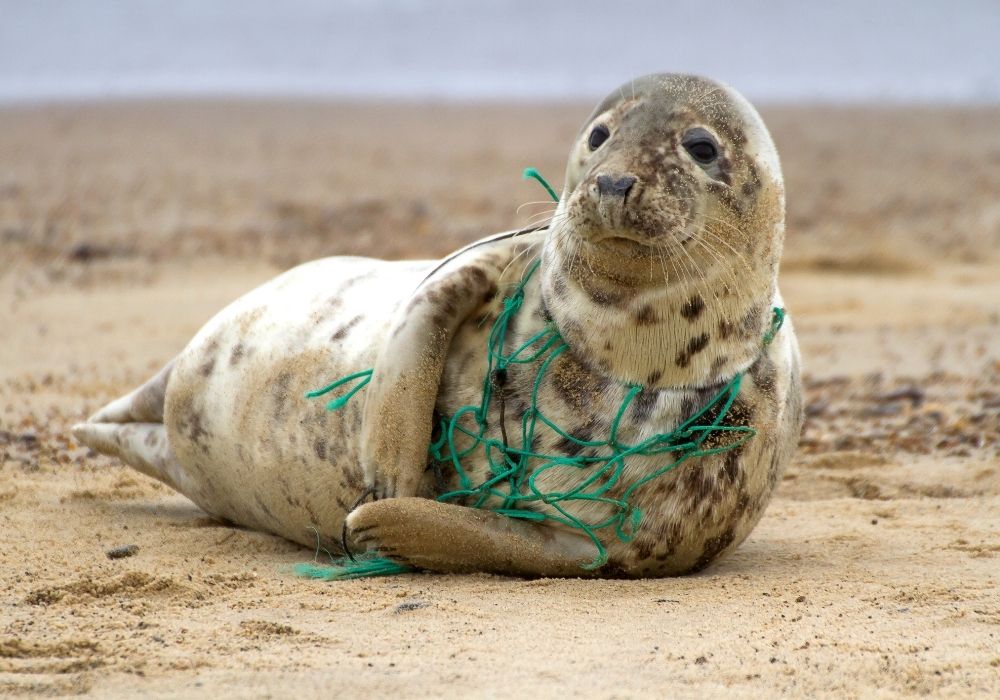
Clearly, the problem is huge. And many people – individuals and organisations – bury their heads in the sand. However, if we don’t make an effort to do something about our plastic problem now, things will only get worse.
If we don’t do enough to put the brakes on the plastic problem, the environment in the oceans will continue to degrade. This means that even more sea animals will be killed from ingesting plastic, suffocating, and becoming entangled in plastic.
The death of millions of marine animals is tragic enough on its own. But when large volumes of creatures die out, this disrupts delicate ecosystems and has a knock-on effect on the other organisms on the planet, including humans.
Plastic has been found in around one-third of fish caught around the UK. Because of the damaging chemicals that plastic is made from, we are more likely to get more immune, reproductive, neurological and other disorders if the plastic in the food chain continues to increase. This also goes for other species as well as humans, having an impact on the wider ecosystem.
We also need to reduce our plastic consumption, not just dispose of it, because even if it does not get into the ocean, burning it as waste releases CO2, and increases global warming.
An additional reason to clean up our plastic problem is that it impacts the tourism industry, which has an impact on jobs and the economy, with 80% of tourism taking place on the coast. Tourist destinations in South East Asia often have to close their beaches for a set period of time to clean up all the plastic pollution on the beach.
What can we do about the ocean’s plastic problem?
Unfortunately, we cannot clear the oceans of the plastic that is currently in there, but we can stop even more plastic getting into the oceans.
Some of these actions we can take ourselves. And some are actions that need to be taken on behalf of organisations and government.
This section is broken down into ways that you can help with lifestyle changes, and how you can advocate to companies and governments to stop ocean plastic pollution.
Individual action
Reducing our dependency on single-use plastic may seem like an impossible task. But, if everyone plays their part, we can start to right our plastic wrongs. But how do we do it?
The answer is to reduce the amount of plastic we consume. And for all other plastic, reuse it, and if it can’t be reduced or reused, recycle it. Reduce is far and away the most important of the three.
Why is reducing plastic the most important thing to do?
Reusing and recycling plastic are better than plastic getting into the ocean or plastic getting incinerated, but the best option is for it not to be produced in the first place.
Plastic can seem impossible to avoid in today’s society. There have been some positive nationwide moves, such as banning plastic straws. Although disposable plastic has increased again due to the coronavirus pandemic, for example, plastic carrier bags being used by supermarkets.
Remember that plastic never goes away, and recycling also uses up energy. In addition, in some parts of the world, and even in the UK, plastic that cannot be recycled is incinerated, causing air pollution and contributing to global warming.
Scientists estimate that only 2-15% of plastic is actually recycled. In 2018, 10.9 million tons of rubbish was incinerated in the UK, which included plastic.
Also, there are lots of different types of plastics, and they all need to be recycled in a different way because they are made up of different types of chemicals and structures. Plastic bottles can never become plastic bottles again, they have to be turned into something else. This is known as downcycling.
How do I reduce how much plastic I use?
The less plastic we produce, the less plastic will end up in the ocean (or being burned). Although personal consumption is not the sole cause of plastic pollution, it is a large part of it. It is your responsibility as a consumer to try to opt for products that are not made from single-use plastic.
Alternative options for materials are paper, wood, bamboo, glass, ceramic, and metal.
As an individual, there are lots of great choices that you can make about plastic to help reduce your plastic consumption. You can also set a good example for other people and send a signal to companies that you won’t buy items made from single-use plastic.
Here are a few things you can do:
-
- Buy loose fruit and vegetables when you go to the supermarket or greengrocer. Potatoes, tomatoes, courgettes and so on are an easy fix. Some supermarkets, such as Sainsbury’s, have reusable bags for sale that you can buy to fill up when you go to the supermarket.
- Don’t buy products that contain microbeads.
- Choose sustainable containers. It is better to choose bars and creams that come in metal, paper or glass instead of shampoos, laundry liquid and toothpaste that come in plastic containers. Some zero waste shops allow you to refill your own containers with liquid products, such as shower gel.
- Switch to a bamboo toothbrush. If you can’t bear to give up your electric toothbrush, find recyclable toothbrush heads.
- Use a menstrual cup instead of tampons or sanitary towels.
- If you have a baby, use reusable nappies.
- Don’t buy plastic drinks bottles – use a refillable bottle for your water. Some coffee chains also give you a discount if you use your own coffee cup instead of their ‘disposable’ cups.
- Instead of buying mass produced garments, buy clothes made from sustainable and natural fibres, such as wool. For your other clothes, wash them less often, in colder water, and on a gentler spin cycle to avoid more microplastics being dislodged into the water. You can also buy some products to help reduce the amount of microfibres that get into the sewage water, such as a Cora Ball or a GuppyFriend, which pick up the leftover microfibres in your spin cycle.
- Swap your cling film for reusable containers or beeswax wraps. These can be a little on the pricey side but there are tutorials on YouTube which show you how to make your own.
- If you smoke, try to quit. (There are obvious health benefits to this too!)
- Don’t use disposable face masks. Places like Etsy are great for buying handmade cotton masks, which are much less harmful when it comes to plastic pollution.
Lots of these products can be purchased from your local zero waste shop. Eco Thrifty Living has a directory of zero waste shops in the UK. If you don’t have one in your local area, there are plenty of online zero waste shops.
What about the plastic that I can’t avoid?
Even if you reduce the amount of plastic that you use significantly, it can be challenging to free your life of it completely. Which is why it’s important to try and reuse any plastic that you can’t avoid using, to reduce its risk of getting into the ocean.
How do you reuse plastic? Well, you can create new things out of old plastic, otherwise known as upcycling. Here are a few ideas:
- Create a raised bed (or even greenhouse if you are feeling very adventurous) out of recycled plastic bottles.
- Make jewellery and accessories out of old crisp packets.
- Weave a basket out of old plastic bags.
- Make a mosaic out of old bottle tops.
- Make planters for your garden out of old plastic bottles.
Pinterest is a treasure trove full of amazing upcycling projects, so always try to create something out of plastic before tossing it in the recycling and hoping for the best.
Unsurprisingly, we don’t recommend buying new plastic to create these projects! If you’ve succeeded in reducing your plastic consumption but you want to make something out of old plastic, see if you can collect plastic from neighbours to create your project.
And what about recycling?
Always remember that recycling should always be the last resort. Recycling is an energy-intensive process and there are many obstacles to efficient recycling. If you can reduce or reuse plastic, you are helping to manage the problem much more.
Of course, in some circumstances, you won’t be able to reduce or reuse plastic.
In this case, it is really important to find out what your local council does and doesn’t do to recycle plastics, because they all differ. For example, some councils only recycle plastic bottles when they collect your recycling, and other plastic will need to go to a separate recycling centre. If you only rely on the council’s local collection services, a lot of plastic will end up going to landfill, being incinerated or being exported.
Often, there are places locally where you can take other plastics to be recycled, for example, the plastic on food wrapping. That could be supermarkets, car parks, your local zero waste shop or at other locations. If you can’t find one, try asking people who live near you or ask on social media.
And, if you do find some recycling points, make sure you tell your neighbours, friends and family about them to save even more plastic from getting stuck in landfills and being at risk of entering the oceans. You could even offer to take your neighbours’ plastic for them.
Is there anything else I can do?
It probably goes without saying that you should always, always clean rubbish up after yourself when you’re out. Take litter home with you from beaches, parks and lakes. You could even dedicate some time when you’re out to collect litter that you spot on the ground so that it doesn’t get blown into the waterways.
Why not also consider opening up the conversation and taking the initiative to highlight the issue to others at your workplace, school or university. Here are a few things you could do to help raise awareness and reduce plastic waste:
- Organise a beach or river cleanup with your team or peers. One great event is the Great British Beach Cleanup in September every year, but also, there are plenty of other events that happen throughout the year. Search for the river trust in your area and they should be able to point you in the right direction.
- Give or arrange a presentation about ocean plastic to help raise awareness and to inspire your colleagues. Or, if presentations aren’t your thing, arrange for a screening of a video on plastic pollution, for example, from the World Wildlife Fund.
- Look at ways to reduce plastic in your workplace, whether that’s with coffee machines, plastic in the kitchen, or your suppliers. For example, if you usually buy toilet rolls wrapped in plastic, see if you can switch to an eco-friendly company like Who Gives a Crap.
- You may have heard of a swear jar. How about starting a plastic jar? Every time someone uses single-use plastic, they have to put some money in the jar. Although, if nobody in your class or office uses cash, you could also have a scheme where you digitally donate some money to a pot or straight to an environmental charity instead.
When holidays and birthdays roll around, buy friends and family some plastic-free presents or give them a voucher to a zero waste shop. Places like Anything But Plastic sell zero waste gift sets and starter packs. This can help you gently introduce your loved ones to the huge issue of plastic pollution in the oceans.
Or you could do something like sponsor a turtle on their behalf, for example, with the Marine Conservation Society. The money that you raise will contribute to their work in saving the marine environment from plastic pollution. (Plus, who doesn’t want a turtle for their birthday?)
International action
Unfortunately, the plastic problem can’t be resolved in full by individuals. The problem is too large. It needs international cooperation, which means massive changes on the behalf of governments and industry.
Many countries have banned single-use plastic, although there is concern that some countries will backtrack because of coronavirus. It is thought that by the end of 2020, there will be more disposable face masks in the Mediterranean than jellyfish.
There is still a lack of firm regulation around fishing equipment, and that is considered the leading cause of ocean plastic. Greenpeace has been campaigning for this to be made international law, as there are currently only suggestions to be followed and no legal action can be taken if these guidelines are not followed.
You might feel powerless as an individual to change the behaviour of large organisations, but the more people act, the more success we will have. Many actions add up, so if you can support green initiatives and put pressure on companies and governments, as well as take part in advocacy, you can help protect the oceans from plastic pollution.
Of course, if you can start a conversation with those around you about plastic pollution, you may be able to encourage them to take action also. Sign petitions, Tweet your local representatives and companies, and encourage others to do so too.
It is crucial that international law does much more to protect our oceans from plastic pollution. Of course, you can’t change this on your own. But you could support an organisation like Stop Ecocide, which is attempting to put legislation in place to make it illegal to harm the environment.
Other organisations to support include:
- Marine Conservation Society
- 5 Gyres
- Greenpeace
- Plastic Oceans Foundation
- Just One Ocean
- Plastic Oceans UK
Conclusion
“It is, surely, our responsibility to do everything within our power to create a planet that provides a home not just for us, but for all life on Earth.”
Sir David Attenborough
The plastic problem in the ocean is clearly huge, but just like the plastic that’s already in the ocean, it’s not going away. Which is why we all need to act now. Without doing something drastic, , we will harm more animals, more humans, and threaten the balance of the entire planet.
Individually, you can reduce the amount of plastic that you use. That is the most important thing you can do when it comes to lifestyle changes. And for all other plastic, first, try to upcycle, and if you can’t upcycle it, make sure it gets recycled properly.
Also, it is really important to take your time to educate yourself about the issue as much as possible, support plastic-free charities and movements, and put pressure on governments and organisations to make a change.
